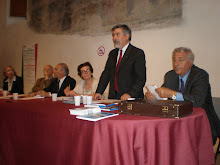The Ukraine crisis has focused minds on addressing Europe’s energy import dependence, but there are no easy fixes.
Climate change has long dominated Europe’s energy agenda. Following the turmoil in Ukraine and Russia’s annexation of Crimea, however, it has had to make room for energy security. The EU had been working towards a final decision on a climate and energy policy framework (registered users), which was due to be made by the summer. But the recent deterioration of the EU’s relations with Russia, an important energy supplier, prompted European leaders to ask the European Commission to prepare an energy security plan. The resulting European Energy Security Strategy, released on May 28th, will be discussed at the EU summit on June 26th-27th; a final decision on an energy and climate policy framework, meanwhile, has been delayed until October.
The EC strategy paper contains few new policy ideas, but calls for the EU to be “hard-headed” about energy security. Member states must demonstrate resilience to supply shocks and disruptions in the short term, while reducing “dependency on particular fuels, energy suppliers and routes in the long term”. The strategy recognises that, while some progress is being made to enhance European energy security, the region remains vulnerable to energy supply shocks and much more needs to be done.
Currently, the EU imports 53% of the energy it consumes, costing it around €400bn per year. Import-dependence is most acute in the case of oil (imports satisfy 90% of demand), followed by gas (66%), then coal (42%), and nuclear fuel (40%). Given that Europe’s conventional oil and gas production are declining, reliance on imports will increase unless new domestic sources are tapped, energy demand growth moderates and renewables assume a greater share of the energy mix.
The aim of the new strategy is therefore to reduce the level of imports and diversify their sources as much as is feasible, while making the European energy market as internally resilient as possible to external supply shocks. At the same time, the strategy paper acknowledges the EU must moderate its need for energy imports in a way that keeps its climate policy goals intact. For their part, environmental groups say that expanding Europe’s unconventional oil and gas production and diversifying its sources of oil and gas imports will merely lock it into a fossil fuel future. Some policies, however, will be complementary to both energy security and de-carbonisation objectives—such as reducing energy demand, improving efficiency and promoting renewables.
The strategy paper has outlined various options for the EU leadership to consider as it tries to strike the necessary balances:
Speed up commitments to improve energy efficiency. The EU is targeting a 20% improvement in energy efficiency by 2020—to be achieved largely in the residential and industrial sectors—which would cut demand for natural gas. Proposed improvements to fuel efficiency in the transport sector would reduce demand for crude oil there. Setting an energy efficiency target for 2030 would also aid efforts to cut carbon emissions and reduce energy demand, but the Commission has shied away from proposing one.
Increase usage of renewables. The EU will reach its target of meeting 20% of energy consumption through renewable energy by 2020, and has proposed renewables should take a 27% share of the EU-wide energy mix by 2030. Growth in the use of renewable energy for electricity generation will eat into the share of gas and coal in the power sector, lowering emissions and reducing the need for imports. Proper carbon pricing will be needed, however, to ensure that coal loses out from the renewables drive more than cleaner-burning gas. At present, owing to low carbon prices, the opposite is true.
Increase domestic production of hydrocarbons, including unconventional oil and gas. The EU is very unlikely to ban hydraulic fracturing (fracking) for shale gas and oil, as some individual member states have done. In fact, the strategy paper states that producing oil and gas from unconventional sources “could partially compensate for declining conventional gas production”, as long as public acceptance is guaranteed and environmental impacts are addressed. It also recommends gaining a better understanding of the EU’s unconventional oil and gas resources to gain a clearer view of whether commercial production is viable. Still, shale gas and oil production will occur unevenly within the EU, and any noticeable impact on supply is unlikely until after 2020.
Diversify sources of gas imports. Europe needs to continue broadening its sources of energy imports, mainly to reduce its dependence on Russia. In 2013 Russian gas fed nearly 30% of EU gas consumption and accounted for nearly 40% of EU gas imports. Diversification has already been proceeding, with liquefied natural gas (LNG) from Qatar and North Africa entering some European markets. The Commission’s strategy identifies the US as a major new source of LNG. Although there is widespread acknowledgement that most North American LNG will flow to Asia, US LNG supply could be facilitated through bilateral trade initiatives such as the Transatlantic Trade and Investment Partnership (TTIP). Nevertheless, price will largely determine where US LNG will be directed. The Southern Corridor route, which will unlock Caspian gas for Europe via the Trans Adriatic Pipeline (TAP) by 2020, could eventually bring supplies from Middle Eastern producers such as Iraq and Iran.
Integrate the European energy market. Integrating the European energy market more closely through building interconnector gas pipeline infrastructure, enabling pipeline reverse flow capacity and enhancing competitive and more liquid markets can help to make Europe more resilient to sudden supply disruptions. In particular, improving internal gas pipeline interconnections would facilitate the flow of LNG, which arrives in western and southern Europe, to parts of the continent more dependent on Russian supplies.
The cost of energy security
Despite the many obstacles noted, there are some grounds for optimism that Europe can make progress towards these objectives. The paper forecasts that lower energy demand and greater use of renewables will compensate for declining oil, gas and coal production, and imports will fall modestly over time. Its inclusion of unconventional sources of oil and gas has angered environmentalists, but reflects a broad recognition within the EU that, given falling conventional output, a blanket ban on fracking will only exacerbate Europe’s import dependence.
Still, achieving Europe’s energy-security objectives will not be cheap. Expenditure worth €200bn is required for energy infrastructure projects capable of significantly reducing Europe’s external supply vulnerability. Just one-half of this is likely to be delivered in the short-to-medium term. (According to the strategy paper, 33 gas and electricity projects are due to be completed or commissioned by 2020.)
The strategy paper implies that, like the US, the EU will follow an “all of the above approach” to tackling its energy security problems. But the document recognises that dependence on energy imports will remain a fact of life for the EU. The best Europe can hope for is to manage this, rather than eliminate it.
Source: Industry Briefing



















































































.jpg)
.jpg)

Nessun commento:
Posta un commento